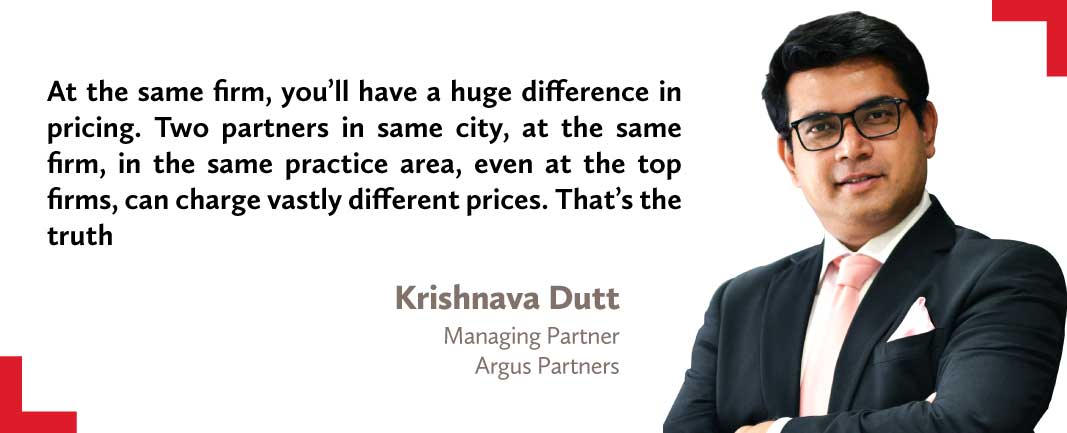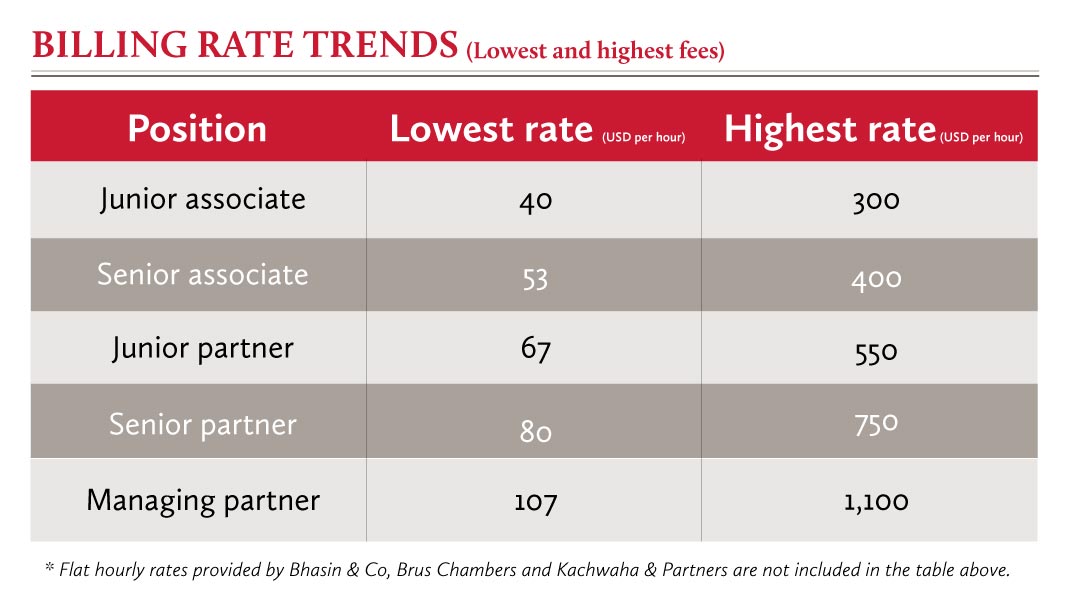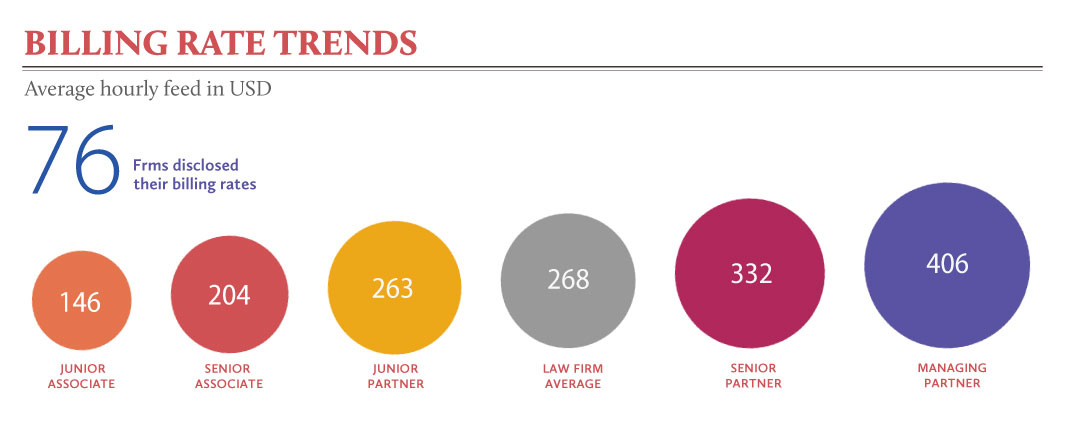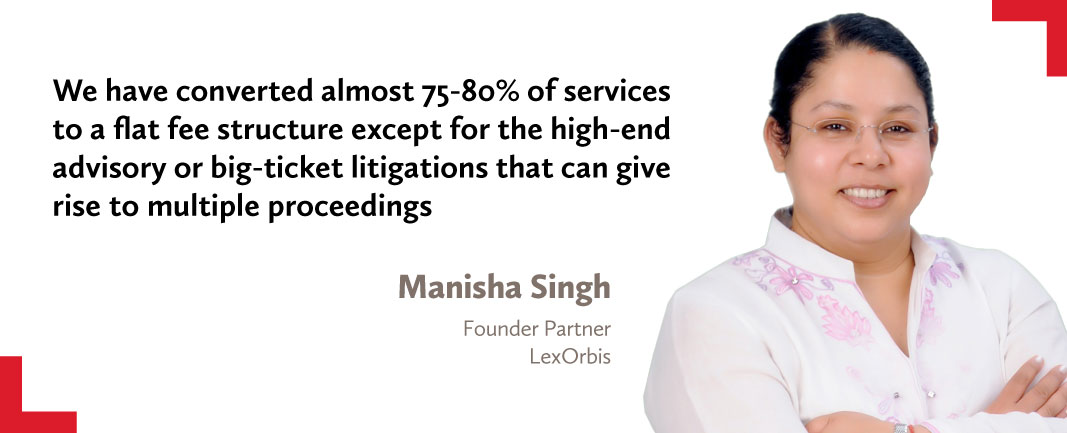Hourly rates bounce back, but legal fees remain competitive as clients push for predictability. Vandana Chatlani reports
I
n the past 18 months, the world has learned to live with the chaos of covid-19. Omicron is the pandemic’s newest kid on the block, wreaking havoc among healthcare institutions, halting travel yet again, and forcing a bigger push towards vaccines and boosters.
Despite the difficulties, law firm have been surprisingly busy. Small businesses have rushed to obtain legal advice to deal with the financial and economic distress brought on by the pandemic. Companies swooped in to pick up distressed assets, worked to meet their contractual obligations, resolved disputes, created online marketplaces, signed vaccine purchase agreements, and much more.
“We have seen a spike in work since covid-19, which has made us a little overburdened, and if this trend continues … fees will rise for sure,” says Hitesh Soni, the founder and managing director of Hitesh Soni & Associates.
Shrikant Hathi, a partner at Brus Chambers, says the firm lowered its billing rates to less than half at the height of the covid-19 pandemic, however, since November, it had restructured its fees to “slightly more than our normal rates, and are more flexible and user-friendly”.
Those who haven’t yet increased their rates are hoping to do so in the coming year. Meenakshi Acharya, a partner at RMA Legal, says she is “very optimistically looking forward in the next 12 months to charging normal billing rates”.
Clients offer mixed reviews about legal costs at Indian law firms. Some suggest that law firms overall offer great bang for your buck, while others lament the lack of openness.
Amar Misra, executive director at RPG Enterprises, says Indian law firms offer good value, with appropriate and fair legal advice. In his experience, firms offer quick turnaround time without compromising on quality, and effective communication, which helps make the decision making process easier and faster.
Ajay Kharbanda, the chief legal officer at GMR Airports, expresses a similar sentiment, commending law firms for their concentrated efforts and good research on matters of precedential value, which helps in devising the right strategies for both litigation and transactional work.
Despite his positive review, Kharbanda says improvements are needed with regard to legal fees. “It’s a bit unfortunate on the billing front, the lack of transparency and visibility on the number of hours spent; charging for counsel at various levels of the firm for a matter; and higher hourly rates,” he says. “This leads to a higher than expected invoice.”
Kharbanda says he would like to see fee structures driven by the success of a transaction. “That will push for enhanced deliverables,” he says. “Litigation funding has adopted this concept and with time we should see this translated into general practice.”
Suprio Bose, vice president at Piramal Capital & Housing Finance, also wants firms to be more upfront about their billing practices. In particular, Bose wants firms to “generate invoices with an itemised breakdown of costs, and timely reminders if an external legal adviser envisages that a mandate will extend beyond budgeted timelines”.
From Sanjay Mitra’s perspective, effective communication between corporate counsel and external advisers is crucial to maximising value and deliverables.
“Good value does not mean negotiating hard and trying to minimise costs, but is actually more outcome driven,” says Mitra, who is the senior managing partner, general counsel and company secretary at IL&FS Investment Managers. “You always get the best value when there is an alignment of interest between law firms and in-house counsel … in-house counsel should be transparent and upfront about their expectations, both on outcomes and costs. If there is clarity on both sides then there is never an issue at the final billing stage.”
A healthy recovery
Against the backdrop of a pandemic that continues to dominate the headlines, we present the results of our 15th annual billing rates survey. The survey is based on an analysis of 76 participating firms, made up of between three and 375 lawyers, from Ahmedabad, Bengaluru, Chandigarh, Chennai, Indore, Kochi, Mumbai and New Delhi. We highlight our findings through a series of infographics throughout this article.
In the past 14 years, most of India’s highest-ranked law firms have refused to reveal their billing rates, citing privacy and confidentiality. Others point out the discrepancy between published rates and actual fees charged.
“Very often than not, we charge differently to the rate we’ve provided,” says Krishnava Dutt, the managing partner of Argus Partners. “I would hazard a guess that would be the same at most Indian firms, if not all.”
Dutt points out that while firms may be committed to transparency and willing to share their pricing models, “no firm will ever stick to their rack rate”.
He adds: “At the same firm, you’ll have a huge difference in pricing. Two partners in the same city, at the same firm, in the same practice area, even at the top firms, can charge vastly different prices. That’s the truth.”

The mix of billing models offered also means that some smaller firms are reluctant to share their fees.
AP & Partners, for instance, says that a large part of its work is conducted on the basis of “value billing”, rather than hourly fees, and thus reporting its hourly billing would not provide an accurate picture of their pricing.
“Several clients still prefer to work on a time-spent basis, which we are happy to do,” says Moksha Bhat, a partner at AP & Partners. “Increasingly, we now also see cases where clients would like legal fees to be linked to client upsides, which also works very well for us. Our sense is that on corporate deals, particularly on the sell side, clients prefer this structure.”
Bhat says the firm is also content to offer fixed fees for specific tasks where time and expected outcomes are easy to estimate. “In the Indian commercial litigation circuit there has always been an element of value billing, particularly for counsel fees,” he says. “The time-based billing model is not as deeply entrenched in the Indian market.”
Ameeta Verma Duggal, the founder of DGS Associates, believes there is plenty of flexibility available with “almost all firms offering various billing arrangements to their clients”. Duggal predicts this trend will continue as clients are now accustomed to having a variety of billing models on offer.
Others are convinced that hourly billing has its place and may gain favour in the future. Spice Route Legal, Singh & Associates, AP Law Chambers and BMR Legal all estimate that 65% or more of their total billing is done using the hourly model (see Hourly v alternative billing).
“Lawyers are used to billing by the hour and clients are used to paying an hourly rate,” says Rashi Suri, the managing partner of Upscale Legal Solutions. “For some clients, this familiarity provides a clear way of comparing one law firm to another. For law firms themselves, hourly billing can be very profitable, particularly in long or complex cases. When the length of a case is unknown, it can be challenging to estimate the workload. An hourly fee enables lawyers and clients to proceed on the basis of recurring need, allowing for increases in workload when required.”
Suri acknowledges the limitations of the billable hour model, and notes a shift to a more customised, fixed-fee model. “An increasing number of clients, both small and large businesses alike, request reliable, predictable prices for legal services,” says Suri. “Quoting a fixed fee forces a lawyer to think more carefully about the strategy they should employ, and about the complexities that may be involved in the project right from the start.”
Nevertheless, India Business Law Journal’s survey continues to offer a benchmark for legal fees, accounting for variations caused by global and local economic realities, market competition, growing in-house teams, and the prestige attached to certain client names. As always, the figures quoted must be viewed carefully, as partners and in-house counsel highlight a continuing trend of discounts, fixed fees and alternative billing models that may drastically lower final invoices.
The inclusion of Lakshmikumaran & Sridharan, and Anand and Anand, in our survey indicates a commitment towards transparent and best-practice billing among the top echelon of law firms. We hope their participation encourages others to share their rates in the future.
While the billing rates shared by Lakshmikumaran & Sridharan, and Singh & Associates, provide an idea of the pricing structures at larger firms, our survey best captures the trends across mid-sized and smaller firms, which make up the majority of participants.
Hourly billing rates have made a remarkable recovery in the past year, climbing across all categories and surpassing 2019 rates, except in the senior partner category.
The average hourly rate for a lawyer rose by 8.5%, from USD247 to USD268 per hour. The sharpest increase appeared in the senior associate category, where the hourly fee soared 11.4%, from USD183 to USD204.
The hourly rate for a junior partner surged 8.2%, from USD243 to USD263, while the junior associate rate rose 7.3%, from USD136 to USD146. The average hourly rate for a managing partner rose by 6.5%, from USD381 to USD406. The smallest increase was in the senior partner category where rates rose modestly by 3.6%, from USD320 to USD322 per hour, meeting 2019 levels.
The desire for predictability
Despite the increase in the hourly rate, lawyers are acutely aware that clients want certainty where legal costs are concerned. More often than not, this takes lawyers away from the hourly model towards fixed fees.

For this reason, he insists on milestone-based payments and pre-estimate fees to keep legal costs under control. “Pandemic or no pandemic, management is looking at all kinds of costs including legal costs,” he adds. “Covid has further increased this focus.”
Mitra, at IL&FS, says he has “never agreed with the concept of hourly billing” and points out that in most cases, corporate counsel end up feeling that they have overpaid. “Whether on transactions or litigations, we try to agree to fixed amounts for each task,” he says. “In cases where the scope is unpredictable, we in rare situations agree to an hourly rate, and that is also closely monitored to ensure that the costs do not overshoot our budget.”
Law firms have adapted to this requirement. “We have converted almost 75-80% of services to a flat fee structure, except for the high-end advisory or big-ticket litigations that can give rise to multiple proceedings,” says Manisha Singh, the founding partner at LexOrbis. “It is safe to say that clients continue to steer the billing practices of the legal industry.”
India Law Offices charges fees per hearing for court matters and for arbitration, and stage-wise fees for all compliance and defined corporate advisory matters. The firm also works on a monthly retainer for clients who have opted for a suite of legal services from the firm.
Bhasin & Co offers a flat “firm rate” of USD300 per hour based on hours of the most senior lawyer involved, while Brus Chambers charges USD117 per hour based on hours spent by the lead lawyer or partner involved. King Stubb & Kasiva offers blended fee arrangements where clients pay a single rate irrespective of the seniority of the lawyer involved.
You must be a
subscribersubscribersubscribersubscriber
to read this content, please
subscribesubscribesubscribesubscribe
today.
For group subscribers, please click here to access.
Interested in group subscription? Please contact us.
你需要登录去解锁本文内容。欢迎注册账号。如果想阅读月刊所有文章,欢迎成为我们的订阅会员成为我们的订阅会员。
Holding the purse strings
Corporate counsel share tips to manage legal spending
Do more work in-house, build confidence in in-house legal advice, and go to external counsel sparingly and on big ticket items. Don’t seek external advice just to cover yourself. It should be to solve an issue that has a high impact and lacks clarity
– Akhil Prasad, India country counsel and company secretary, Boeing
Instead of big law firms, individual lawyers with expertise are more useful and economical
– Rajiv Malik, head of legal, Noida Manufacturing
Corporate counsel should encourage their team to start drafting transaction documents and empowering them to take decisions
– Rajiv Bakshi, former managing director of legal, Essar Capital
Get clarity on the scope of work, do your own homework before approaching external resources, and arrange personal meetings with international lawyers who work for you to develop rapport and trust as a client
– Harsh Aggarwal, general manager for legal, Havells India
Do a cost-benefit analysis before taking up any project involving litigation or any corporate actions such as M&A, due diligence, etc. As far as possible, ensure that there is a fixed fee, and event or milestone-based fees, and not open or only hourly rates. In-house counsel and law firms are in conflicting situations; law firms will always try to maximise billing and as in-house counsel, our key responsibility is to reduce and control legal costs
– Rajiv Choubey, chief legal officer and company secretary, ACC
Planned work allocation among a mix of large and small law firms, negotiated rates for hourly billing and fixed-fee arrangements could be helpful
– PM Devaiah, group general counsel, Adani Group
Most firms have started copying the international billing mechanism, which is hourly, with no connection with the conclusion of work. The best way is to agree in advance on the fixed-fee module and connect it with a return on investment and success
– Roma Arora, joint general manager of legal, Havells India
Spend more time in first identifying the correct law firm for the task. Experiment with newer law firms. If you work exclusively with a few law firms, then the scale of your engagement should result in significantly discounted rates. Second would be break up the assignment. Predictable tasks are those where the scope, time and resources required are easy to estimate – agree on a fixed rate for these tasks. In others, where the scope and time spent could change, try to minimise the uncertainty and if possible indicate your cost expectations upfront with a law firm
– Sanjay Mitra, senior managing partner, general counsel and company secretary, IL&FS Investment Managers































